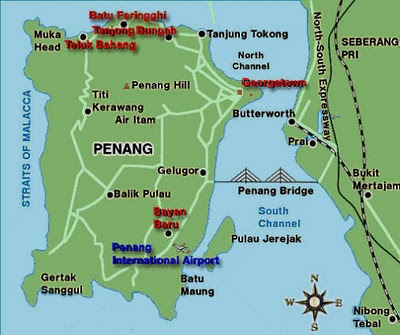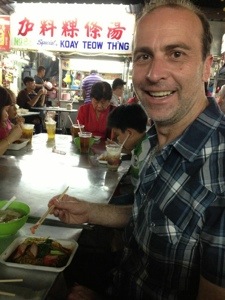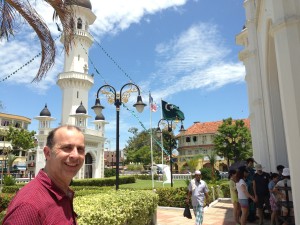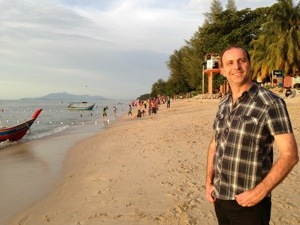Whenever I said I was going to Penang, some people looked at me in confusion. Where was Penang? Was it in Indonesia? Thailand? Many had heard of it but could not quite place it. Those who have been there were universally excited by their visit. I have to admit I had one of the best holidays of my life! As always, with the places I visit, I rated Penang on six key factors.
Aesthetics: 7.5/10
Penang is known as “The Pearl of the Orient” lies on the north-western coast of the Malaysian Peninsular. The state comprises an island of some 285 sq. km and a narrow strip of approximately 760 sq. km on the mainland known as Seberang Perai (Province Wellesley separated by a channel 3 km wide at the closest point). The island and the strip are linked by the 13.5km (8 mile) Penang Bridge and a 24-hour ferry service. Penang Island has a population of over 700 000, one of the most densely populated places in Malaysia. Most settlement seems to be on the East of the island.
 Penang’s main settlement: George Town is a UNESCO World Cultural Heritage Site. The Town was founded by Captain Francis Light, soon after his arrival in 1786. His son Colonel William Light went on to found the Australian city of Adelaide. Some of the buildings that were constructed around Light’s time still stand. In this area, many of the 18th and 19th century buildings are in a local style known as Straits Eclectic, a fusion of Eastern and Western influences. While some are in disrepair, others have been stunningly restored. Tucked in the streets are temples, mosques and churches.
Penang’s main settlement: George Town is a UNESCO World Cultural Heritage Site. The Town was founded by Captain Francis Light, soon after his arrival in 1786. His son Colonel William Light went on to found the Australian city of Adelaide. Some of the buildings that were constructed around Light’s time still stand. In this area, many of the 18th and 19th century buildings are in a local style known as Straits Eclectic, a fusion of Eastern and Western influences. While some are in disrepair, others have been stunningly restored. Tucked in the streets are temples, mosques and churches.
Around Georgetown is a bustling modern metropolis with tower blocks crammed onto a triangular spit of land. A small hilly range rises steeply up in the middle of the island and there is a beach area to the north of the Island. At the far edge North West corner is the Penang National Park.
Culture: 8.6/10
Penang has long been a multicultural island with races from across the world visiting and staying. Approximately 44 per cent of the island are Malay, 46 per cent Chinese and ten per cent Indian with Burmese, Vietnamese, Indonesians, and Thais making up the rest. The city is renowned through Malaysia and further for its food culture especially from the Hawker stands (see below). There are also a huge range of cultural festivals. We were there for Hari Raya Aidilfitri, the Muslim celebration which follows the Ramadhan fasting month and the Chinese were celebrating their Hungry Ghost Festival.
Penang has a very active arts, photography and music scene. There were lots of things we would have liked to have seen but we ran out of time.
Crime and Safety: 8/10
There is a criminal element in Penang but visitors will not be impacted as the tourist areas including Georgetown and the resorts are safe. There are, of course, the usual petty crimes perpetuated by scam artists, pickpockets or opportunistic individual. We felt very safe apart from some horrendous drivers! Public drunkenness is illegal. Malaysian law requires all foreign visitors to carry their passport with them at all times. I kept mine at the hotel and carried a photocopy because I dont like having my passport with me. The telephone number for emergency services is 999.
Livability: 9/10
If you enjoy tropical weather, Penang is a great place to live! The weather is pretty constant through the year. It will be hot during the day and Heavy Rains in the evenings. The average high temperature sits in the low 30s year round and the low temperature in the low 20s. There is a rainy season (April to November) and a dry season (December to March).
The cost of living is approximately 40 per cent less than in Australia with some things costing way less. We found cheap meals were $US3 each. Our most lavish expensive dinner cost us $US20 each. Alcohol is not cheap. Dairy products were very expensive. My haircut was $3. Movies were $3. Clothes were cheap. Electronics were on par or a little more pricey. Malaysia a non tipping country but there is no harm tipping when you recieve good service.
Transport: 4/10
Roads are very clogged across the island. George Town has a system of one way streets, some of which seem to have changed recently.
There is a comprehensive regular bus service operated by Rapid Penang across the island. Fares are per distance travelled and are paid by exact fare on boarding or through a card. You can buy a tourist card valid for a week for RMB30. Buses can be a little slow but are very comfortable. We talked with one tourist who had been pick pocketed on the bus so exercise caution.
Taxis are good and cheap. Make the driver stick to the meter or you will pay a higher fare. A good taxi driver knew how to avoid the worst traffic spots.
The 24 hour ferry service to and from the island is the oldest ferry service in Malaysia. Ferries connects Sultan Abdul Halim ferry terminal in Butterworth on the main land with Raja Tun Uda ferry terminal at Weld Quay in George Town every 10 to 15 minutes. The ferries are “roll-on/roll-off” car ferries with pedestrian and bicycle traffic also carried. You pay to go to the island and it is free to leave.
The small but modern airport has connections to destinations in nine countries. There are bus services from the airport which are very cheap. One of the routes (101) even has free wifi on board. A taxi is much faster. Before finding a taxi, find the taxi counter in the arrivals hall. The staff on duty there will find out yoiur destination, take your money and issue you a voucher for the taxi ride. This is an attempt to get around dishonest taxi drivers.
You can also cruise from Penang to Phuket, Thailand.
Vibe: 10/10
Penang is a fun, bustling place with friendly people. The place operates 7 days and 7 nights a week.
The Verdict: 72%
I ranked Penang at 77th on my list of top cities, a similar ranking to Cardiff and Manchester in the UK and San Jose, California.
Penang Top Ten
1. George Town Streets
We absolutely loved the streets of historic George Town. It is by no means a static museum. Life goes on. I got my hair cut at a Chinese barber ($US3 including tip), ate at street stalls, roadside restaurants, and coffee shops, and browsed at the stylish shops, tourist junk outlets and antique stores. There are guided walking tours and we passed many tourists with their noses buried in Lonely Planet guides but we were content to wander. Sometimes we went past the same section multiple times and at other times we found ourselves “lost” in an old world. Here is a listing of its streets.
2. Hawker Stalls
From the 19th century, Penang had a culture of selling ready to eat food on the street. The tradition continues. All over the city, people make the most delicious meals in front of you. You browse past a stand, order your food and then perch on outdooor tables and chairs to eat it. We sampled the best Ice Kachang in Malaysia, fruit filled Apam pancakes, dim sum, Wan Than Mee (which I saw advertised at one outlet as wanton noodles!) and fried oysters.
3. Harmony Walk
This walk took us through the streets of George town to visit key religious institutions of the city. It includes St Georges Anglican Church, the 18th century Buddhist Goddess of Mercy Temple, the Sri  Maha Mariamman Kovil Hindu temple on the island with a garish tower of 38 statues and the Tamil Muslim Kapitan Keling Mosque. There are tours that will take you to these places but we enjoyed exploring them on foot, by ourselves ,at our own pace. There are plenty of places to buy drinks and snacks en route. It is important to dress modestly as some of the places have strict rules. The mosque provided purple hooded coverings if needed.
Maha Mariamman Kovil Hindu temple on the island with a garish tower of 38 statues and the Tamil Muslim Kapitan Keling Mosque. There are tours that will take you to these places but we enjoyed exploring them on foot, by ourselves ,at our own pace. There are plenty of places to buy drinks and snacks en route. It is important to dress modestly as some of the places have strict rules. The mosque provided purple hooded coverings if needed.
4. Penang Hill and Penang Botanic Garden
Rising 821m is the hill which locals call Bukit Bendera. We took the Penang Tram funicular railway ($US10 roundtrip). On reaching the top, we found it was about five degrees celsius cooler than Georgetown- all year around. The hill is covered in a remnant of tropical rainforest which we walked through. The flora and fauna here have been protected since 1960. At the bottom of the hill is a relaxing Botanic Gardens -filled with not so relaxing monkeys!
5. Clan Jetties Floating village
This is an entire village that is built on stilts over the water. It was built in the 19th Century by Chinese immigrants when they came to Malaysia. I found it fascinating walking along wooden paths checking out the wooden houses and trying to both simultaneously take a peek inside without looking like we were looking!
6. Penang War Museum
Built on the site of an original British defence complex which was used as a fort during World war Two, it gives a very clear picture of the impact of war on Malaysia.
7. Penang National park
The park is home to 417 flora and 143 fauna species .There are two nature trails, a 250m long Canopy Walk which hovers 15m from the ground with only ropes for support, no nails, screws or bolts were used. The Park has some of the best beaches in Malaysia including a turtle nesting beach.
8. Ferringhi beach
 This is where many of Penang’s resorts are located. The beach is certainly very nice-although very busy. There are a lot of tourists about. Frankly, we found the food here very tourist oriented and not as authentic. The markets here were awful. Cheap sunglasses, “genuine” Armani handbags, t shirts, DVDs etc. Huge tourist trap.
This is where many of Penang’s resorts are located. The beach is certainly very nice-although very busy. There are a lot of tourists about. Frankly, we found the food here very tourist oriented and not as authentic. The markets here were awful. Cheap sunglasses, “genuine” Armani handbags, t shirts, DVDs etc. Huge tourist trap.
9. Fort Cornwallis
Built by Captain Light in the shape of a star, this fort never was used in a battle. Today it is a privately held museum. It was an interesting place but the interpretative signs and displays need some work and we found staff had little interest in the guests. We enjoyed the cafe inside.
10 Penang State Museum
The State Museum gives a helpful introduction to Penang life albeit with some amusing errors. For example, there were American cars being driven in Penang in 1806. Staff were not overly welcoming.
Related Posts
Dull Dunedin? (83%)
Incredible Istanbul (85%)
Buenos Aires, Argentina (84%)
Marathoning in Hobart (84%)


Like your blog, and agree with everything, except one thing. When the normal custom is non-tipping, I think it does cause harm to tip. It creates an expectation which will, in time, cause problems for both future travellers and locals. Tipping is a malignant custom in so many ways and we should be trying to eliminate it (and foster the payment of proper wages instead – in the US, where tipping is obligatory, the minimum wage is half what it is in Australia). Aside from that quibble, I enjoy your blogs and there is so much useful information in them. I am hoping to get to Malaysia again next Christmas, as we are making a family trip to have Christmas with my daughter-in-law’s family in Sarawak. Glad you enjoyed your holiday.
@ June Miller:
“When the normal custom is non-tipping, I think it does cause harm to tip” – I TOTALLY agree with you!
@ Martin: To rank Penang along the lines of Cardiff and San José doesn’t do it justice, I think, and it does not match your overall enthusiastic description.
How is the air quality in Penang relative to other parts of SE Asia?
air quality good while we were there. It can get bad: http://www.themalaymailonline.com/malaysia/article/haze-in-penang-worsens I also understand that severe fires in Indonesia can result in smoke drifting up to Penang.
Enjoyed your blog! Quick question – my husband and I are considering visiting Penang during the Hari Raya Adilfitri long weekend (same holiday as when you were there). Did you find it over-crowded at tourist attractions, streets and restaurants with horrendous traffic? Or was it manageable? Thanks!